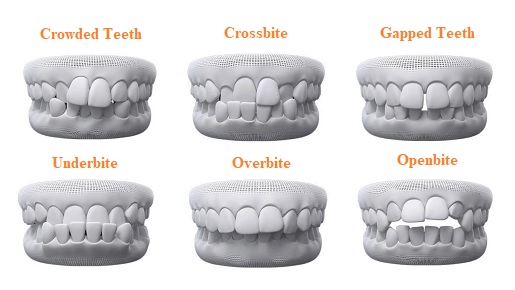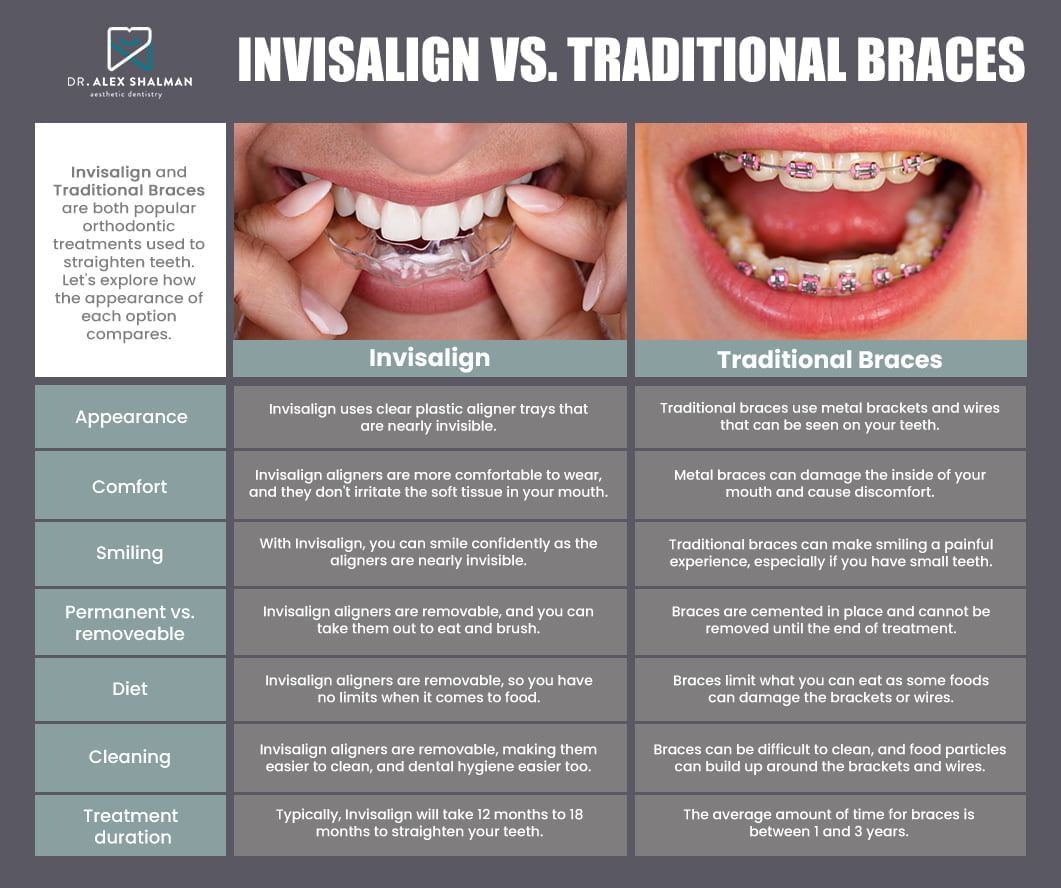Keeping Oral Health While Making Use Of Invisalign: Tips for a Smooth Experience
Keeping Oral Health While Making Use Of Invisalign: Tips for a Smooth Experience
Blog Article
Invisalign vs. Standard Dental braces: Which Option Is Right for You?
When considering orthodontic therapy, the selection in between Invisalign and standard braces presents several vital variables that warrant cautious examination. Invisalign provides a discreet choice with detachable aligners, while standard braces provide an extra noticeable yet effective solution for extreme misalignment.
Overview of Therapy Choices

On the other hand, typical braces consist of metal brackets and cords that are bonded to the teeth. This approach applies continual pressure with time to attain positioning. While reliable for complex orthodontic concerns, conventional dental braces call for routine check outs for adjustments and can present obstacles in maintaining oral hygiene because of the trouble of cleaning around cables and braces.
Both alternatives have their benefits, and the option commonly pivots on details oral conditions, way of life preferences, and individual conformity. Inevitably, consulting an orthodontic professional is important for figuring out one of the most ideal therapy strategy customized to specific demands. Recognizing the subtleties of each option can substantially affect the total success of orthodontic treatment.
Visual Factors To Consider
A substantial variable affecting the selection in between Invisalign and standard braces is the aesthetic appeal each treatment offers. Invisalign aligners are crafted from clear plastic, making them practically unnoticeable when worn. This discreet look is especially attracting young adults and grownups who may really feel awkward concerning their orthodontic treatment. The ability to maintain an all-natural smile throughout the positioning process can significantly boost the individual's confidence in specialist and social settings.
In contrast, standard braces include steel brackets and cords, which can be much more noticeable. While advancements in orthodontic modern technology have brought about the advancement of smaller braces and colored elastics, standard braces still keep a more obvious profile. For some people, the visibility of dental braces might prevent them from seeking needed therapy.
Eventually, the choice in between Invisalign and traditional dental braces might rest on individual choices concerning aesthetic appeals. Patients who focus on discernment frequently favor Invisalign, while those that are less worried concerning visibility may decide for traditional braces. Comprehending the aesthetic ramifications of each alternative is crucial for making a notified choice that straightens with one's lifestyle and preferences.
Comfort and Convenience

In terms of convenience, Invisalign aligners are detachable, making it possible for people to appreciate their preferred foods without restriction and maintain optimum dental hygiene. Brushing and flossing are streamlined, as the aligners can be gotten during these regimens, whereas standard braces require mindful navigating around brackets and cords.
In addition, Invisalign's modern system allows for less orthodontic check outs. Individuals typically obtain several sets of aligners at the same time, which can improve the therapy process and reduce time invested in the orthodontist's chair. In contrast, standard braces demand regular changes, making them less hassle-free for those with busy timetables. Invisalign. Overall, the convenience and comfort of Invisalign make it an enticing selection for several people looking for orthodontic treatment.
Therapy Period and Effectiveness
While both Invisalign and typical dental braces are efficient in remedying oral misalignments, the duration of treatment can differ significantly between the 2 alternatives. Generally, Invisalign therapy can take anywhere from 12 to 18 months, relying on the intricacy of the case. The clear aligners work by slowly moving teeth right into their wanted placements, site link and regular follow-ups with an orthodontist help guarantee development remains on the right track.
In comparison, typical dental braces often require a longer commitment, typically ranging from 18 months to three years. This is because of their fixed nature and the use of braces and cords, which can be more effective for severe misalignments and intricate instances (Invisalign). The therapy efficiency of standard braces is well-documented, as they permit accurate adjustments and greater control over tooth movement
Ultimately, the option in between Invisalign and typical dental braces might rest on both the anticipated therapy period and the certain dental issues at hand. Consulting with an orthodontist is crucial, as they can provide customized suggestions based on individual demands, making certain the picked technique aligns with desired durations and outcomes.
Price Contrast and Insurance Coverage Choices
Cost plays a significant duty in the decision-making procedure for individuals considering orthodontic therapy, whether selecting Invisalign or conventional braces. Typically, the cost of Invisalign arrays from $3,000 to $8,000, while standard braces typically set you back between $2,000 and $6,000. Elements affecting these costs consist of the intricacy of the case, the duration of therapy, and geographical location.
Insurance coverage can considerably influence out-of-pocket expenditures. Many oral insurance strategies offer partial insurance coverage for orthodontic treatments, yet the specifics can vary commonly. It is essential for people to evaluate their insurance coverage to figure out the extent of protection for either alternative. Typically, standard dental braces may be a lot more regularly covered by insurance coverage strategies contrasted to Invisalign, which some insurance companies classify as a cosmetic procedure.
Additionally, numerous orthodontic techniques offer versatile repayment plans, making both therapy choices extra accessible. Clients ought to ask regarding prospective funding choices and discount rates for ahead of time settlements. Reviewing the complete price, consisting of insurance policy advantages and layaway plan, is necessary you can try here for making a notified decision that lines up with both aesthetic preferences and budget factors to consider.

Conclusion
In summary, the choice between Invisalign and traditional dental braces depends upon numerous aspects, consisting of aesthetic preferences, convenience, therapy period, and expense. Invisalign provides a discreet, detachable alternative that assists click here for more info in oral hygiene and nutritional adaptability, while standard braces may be more ideal for complicated dental issues and often come with a lower price factor. Eventually, examination with an orthodontist is vital to examine individual circumstances and establish the most appropriate therapy choice for achieving optimum dental placement.
When taking into consideration orthodontic treatment, the selection between Invisalign and traditional dental braces presents numerous essential factors that warrant careful analysis.Comparing Invisalign and typical braces discloses unique therapy choices for orthodontic improvement.While both Invisalign and standard dental braces are efficient in dealing with dental imbalances, the duration of therapy can differ substantially in between the two alternatives.Cost plays a considerable duty in the decision-making process for people considering orthodontic treatment, whether deciding for Invisalign or conventional dental braces.In recap, the choice between Invisalign and typical braces hinges on numerous factors, including visual choices, convenience, treatment duration, and price.
Report this page